The Google Pixel C Review
by Brandon Chester & Joshua Ho on January 25, 2016 8:00 AM ESTGPU Performance
Even to this day, Tegra K1 has held the crown for best GPU performance in a mobile Android device. From one point of view this is quite impressive, as it shows how NVIDIA was able to build a GPU that no other SoC vendor apart from Apple was able to beat. From another point of view, it's quite concerning to see that nobody apart from Apple values GPU performance enough to try and beat NVIDIA's chips.
Being an NVIDIA SoC, Tegra X1 is paired with a GPU designed in-house by NVIDIA. More specifically, it’s a 256 core part based on their Maxwell architecture. We’ve already seen how this GPU performs in the SHIELD Android TV, but due to being battery powered and having stricter thermal constraints, there will obviously be differences in performance between it and the Pixel C. In this case, it appears that the GPU is also running at a lower frequency than the SHIELD Android TV. While it has been estimated that the SHIELD Android TV's version has a peak GPU frequency of 1GHz, I believe the implementation used in the Pixel C has a peak GPU clock of approximately 850MHz. It’s also worth noting that the Pixel C uses the open source Nouveau kernel drivers that differ from NVIDIA’s kernel drivers on the SHIELD Android TV and SHIELD Tablet K1, and it doesn’t have full OpenGL support which has been the case with Google’s previous Tegra-powered devices as well. With all that in mind, lets dive into our standard mobile GPU test suite to evaluate the GPU performance of the Pixel C.
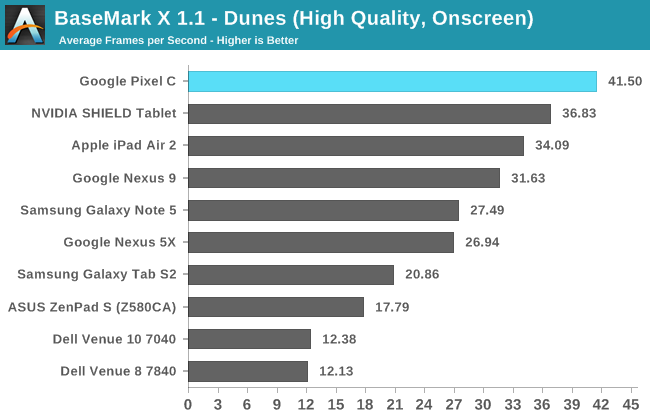
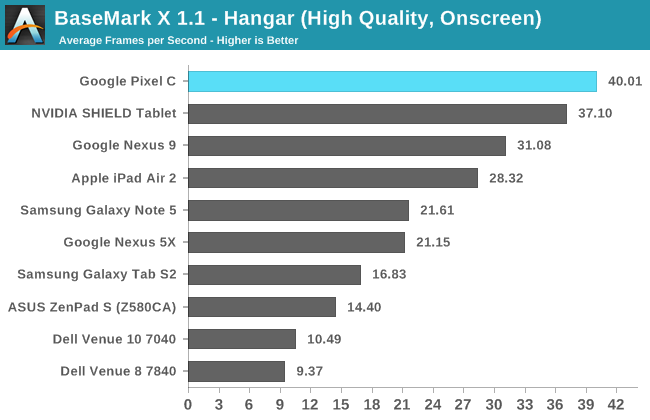
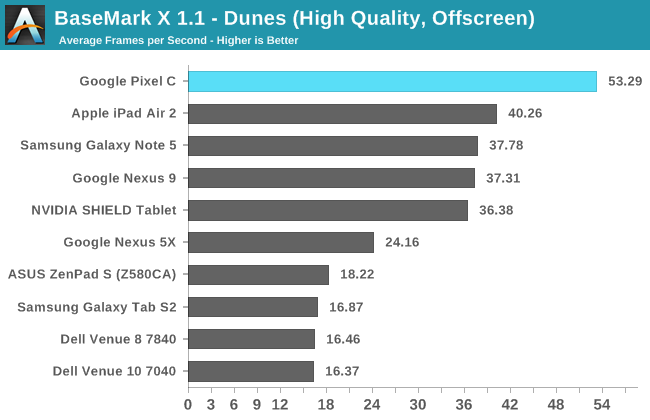

There's not a whole lot to be said about the Pixel C's performance in BaseMark X beyond saying that it's faster than any other Android device by a large margin. Even in the on screen tests, the Pixel C with its substantial resolution is still the fastest device on the charts. Absolute GPU performance as shown in the off screen tests shows a 43% performance improvement over the Tegra K1 used in the Nexus 9.
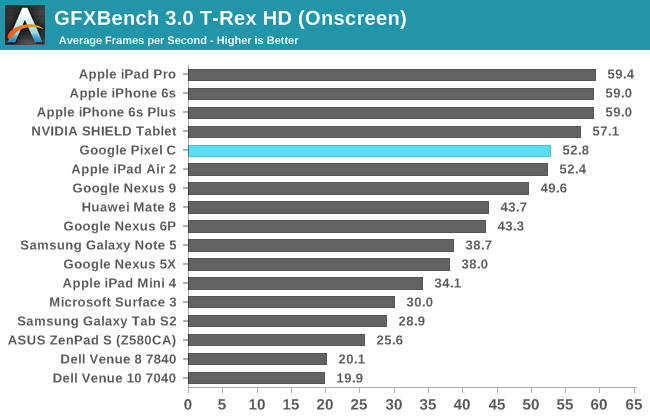
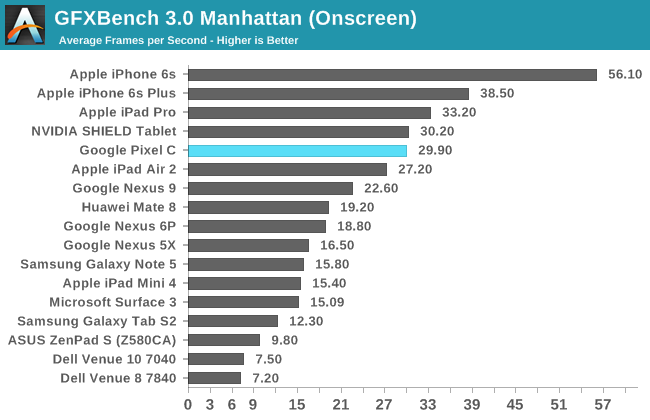
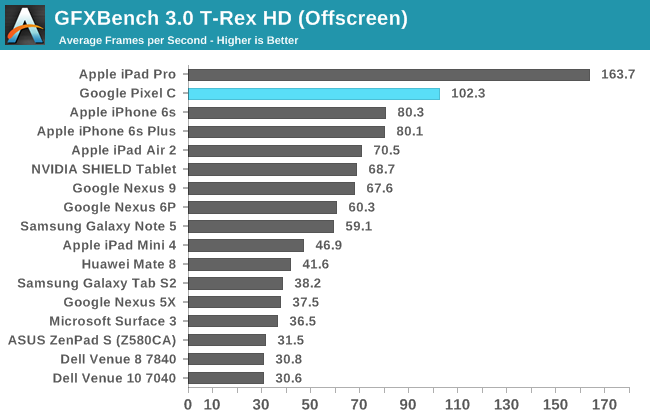
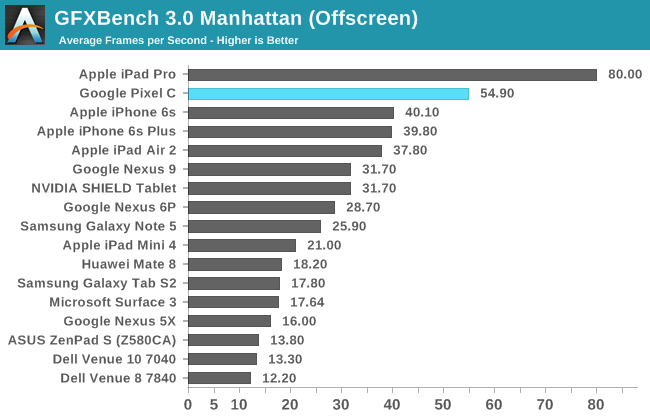
In GFXBench's T-Rex on screen test the Pixel C comes very close to hitting the Vsync limit despite its relatively high resolution. Off screen performance in both T-Rex and Manhattan is exceptional, and both tests make it clear that the Pixel C has the most powerful GPU in any mobile Android device. The gap between it and the next fastest device is quite large too, and the only tablet that can beat it is the iPad Pro with its A9X SoC.
The GPU performance of the Pixel C is unparalleled in the Android space. Not only that, but it ends up being faster than any similarly sized tablet, including the iPad Air 2 and of course the Nexus 9. It’s certainly impressive, and while I don’t mean to take away from the achievement, I can’t help but wishing that we had seen Tegra X1 come to market a bit sooner. Beating out A8X and Tegra K1 is great, but the former of those SoCs is also now well over one year old. While comparing to the iPad Pro is unfair in some respects due to the size difference, both devices do sell themselves as tablets priced for productivity, both launched at around the same, and NVIDIA’s GPU isn't as fast as the one in A9X. That being said, at $799 the iPad Pro is also significantly more expensive than the Pixel C, and relative to its price the Pixel C offers amazing GPU performance. The only concern would be if A9X shows up in some sort of regular sized iPad priced at the same level as the Pixel C. While I certainly do wish we could have seen Tegra X1 in some sort of tablet a bit earlier in the year, right now it does stand as the chip with the fastest GPU to ship in a standard size tablet, and I don’t think it will disappoint even when playing the most intensive 3D games.
Storage Performance
Something that hasn't been investigated very thoroughly in the past is smartphone storage performance. However, among high end devices this is now becoming a point of differentiation. Apple has moved to their own storage solutions that use NVMe and run over PCIe, while Samsung is pushing forward with UFS 2.0. While the Pixel C is a premium tablet, it ships with a standard eMMC storage solution. It also has Google's disk encryption enabled, which has been shown to impact storage performance in the past.
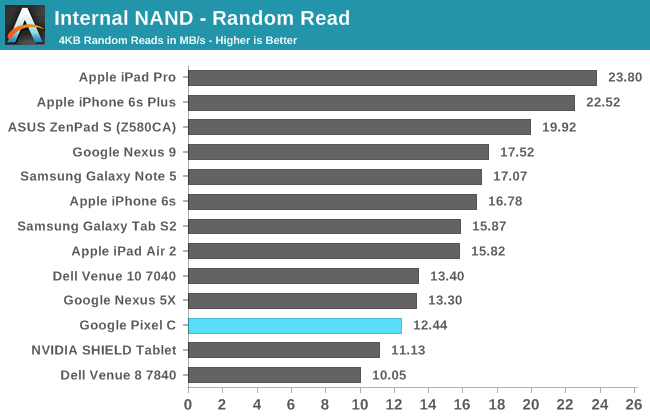

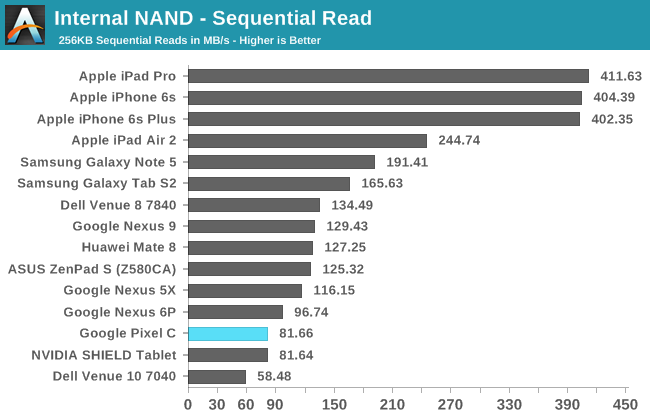
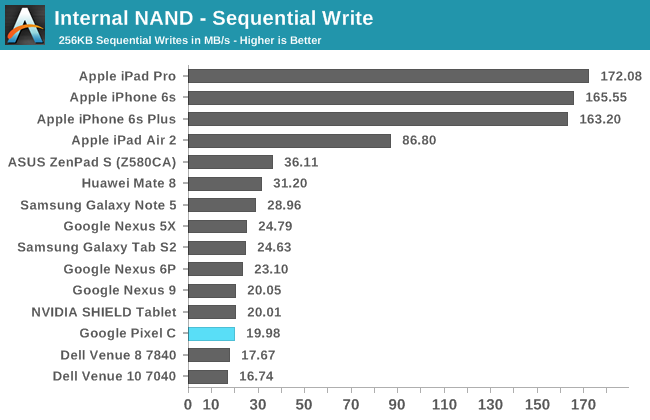
Like every Android device that Google has been involved in developing, the Pixel C doesn't fare well with our storage performance tests. Random reads and writes decent, although not competitive with new storage solutions like the SSD in the iPhone 6s and iPad Pro. Sequential speeds are simply not good at all, and definitely not competitive with what you'll get in an Apple device from the past two years or anything with an unencumbered and halfway decent eMMC or UFS storage solution. There's not much point in going over this issue again, because at this point it's clear that Google doesn't consider storage performance to be a metric worth competing on. I think it is, and I think that users end up appreciating the benefits of faster storage through quicker app installations, less loading when working with large files, among other benefits, even if they don't know what's driving those improvements behind the scenes. It's definitely something to think about when considering the Pixel C as a tablet, especially if you have a productivity focus.










122 Comments
View All Comments
osxandwindows - Monday, January 25, 2016 - link
No I meant the pro tablets from samsung.Ratman6161 - Monday, January 25, 2016 - link
Where to start on a comment like that...but then why bother. Its so blatantly untrue its not worth it.McDuncun - Tuesday, January 26, 2016 - link
Hahahaha what?xthetenth - Monday, January 25, 2016 - link
Yeah, I'll talk down on the iPad Pro in comparison to the Surface Pro by calling it a big phone, but that's a rhetorical thing to point out how many places the iOS ecosystem doesn't have options for the capability x86 Windows has. This is literally a big phone and doesn't even offer anything more. It doesn't have multitasking. It doesn't have apps that use its bigger screen. There's no reason to be carrying the size and weight of a 9" device because you don't receive the capability of a 9" device.MikhailT - Monday, January 25, 2016 - link
I have both iPad Pro and SP4. I like SP4 but there are far more glitches and annoyances with it that I don't get on iPad Pro. Driver crashes, horrible dynamic display power switching BS that you must install Intel drivers separately to disable which MS then decided to switch back to Intel drivers to re-enable without asking me first, W10 app often resets without of nowhere, and so on.iPad Pro? None of that, I did not experience any issues with it and it has far more useful tablet apps for me.
However, MS is definitely much better at multi-tasking but iOS 9 has drastically improved the multi-tasking as well. I can't wait to see what Apple does with iOS 10 and so on and maybe Redstone updates as well.
If nothing drastically is improved with W10 on Surface, I'm sticking with iPad Pro from now on as my primary device.
MikhailT - Monday, January 25, 2016 - link
Blah, can't edit, I meant to say switched back to MS provided drivers instead of Intel.xthetenth - Monday, January 25, 2016 - link
Yeah, the SP4 has been flaky early, although I've been lucky and it's just a ten second annoyance when starting up for the morning and then it's amazing for the rest of the day. I'm not a huge tablet app user, I use the built in apps but don't need much more for pure tablet use, it's really halfway between tablet and laptop for me. I think the two are more likely to be differentiated by user need than anything else.R. Hunt - Monday, January 25, 2016 - link
Lol... as if Windows Store wasn't a wasteland.Speedfriend - Monday, January 25, 2016 - link
No tablet apps for Android? I have two Android tabs and there are apps that for everything I need it for? And while my iPad has plenty of Apps, I find the home screen design which is just a scaled up phone quite annoying, with giant icons and wide open spaces.MikhailT - Monday, January 25, 2016 - link
So, your only issue with iPad is the home screen?So, how often are you looking at your home screen? A few folks say this all the time but the amount of time I care about the home screen is less than 1%. I always find my apps via app switcher since I never need to shut any down and via Spotliight search as needed.